Weaving 8 Dishtowels For a Fiber Experiment
In this video, I am introducing to you my new loom: a 4-shaft Dorothy loom from Leclerc. And what better way to present this new acquisition than to do it with a fiber experiment! With this experiment, I have decided to settle a long-lasting argument: what fiber is the most absorbent? So, I’m weaving 8 dishtowels for a fiber experiment, all of them with a different weft yarn. I also went a bit crazy and I wove different patterns into most of them.
Disclaimer: Links included on this page might be affiliate links. This means that if you purchase a product or service with the links that I provide, I may receive a commission. Please note that there is no additional charge to you. This helps me keep going and create more tutorials.
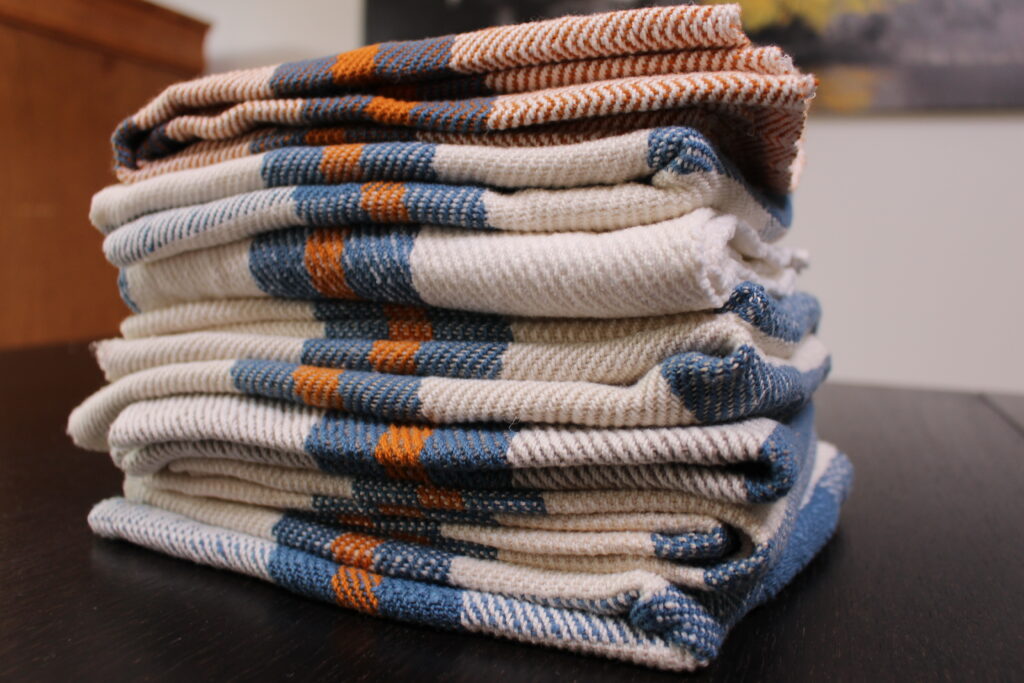
Soon, I will be presenting the results of my research. However, this will have to wait a few weeks! This is because, some of the fibers used in this experiment are their best selves after being washed a few times. I will thus use them for at least 10 times and then conduct the final testing.
The First Part
For this post, my focus is mainly to share with you my plan. This is the first part of weaving 8 dishtowels for a fiber experiment, I will also explain to you what pattern I did for the warp and for each individual towels. For this project, I designed the warp pattern myself. For the weft pattern, I used the drafts provided in Anne Dixon Book: The Handweaver’s Pattern Directory in between pages 32 to 36.
If you are in the US, here’s where you can get this book: https://woolery.com/handweavers-pattern-directory.html?aff=214
The Warp Pattern
For the warp, I used 8/2 cotton in three different colors:
-Vieux Bleu-94 (old blue)
-Orange Brulé-8265 (burnt orange)
-Naturel-100 (Natural)
Here’s where you can get those yarn in the US: https://woolery.com/maurice-brassard-cotton-yarn-8-2.html?aff=214
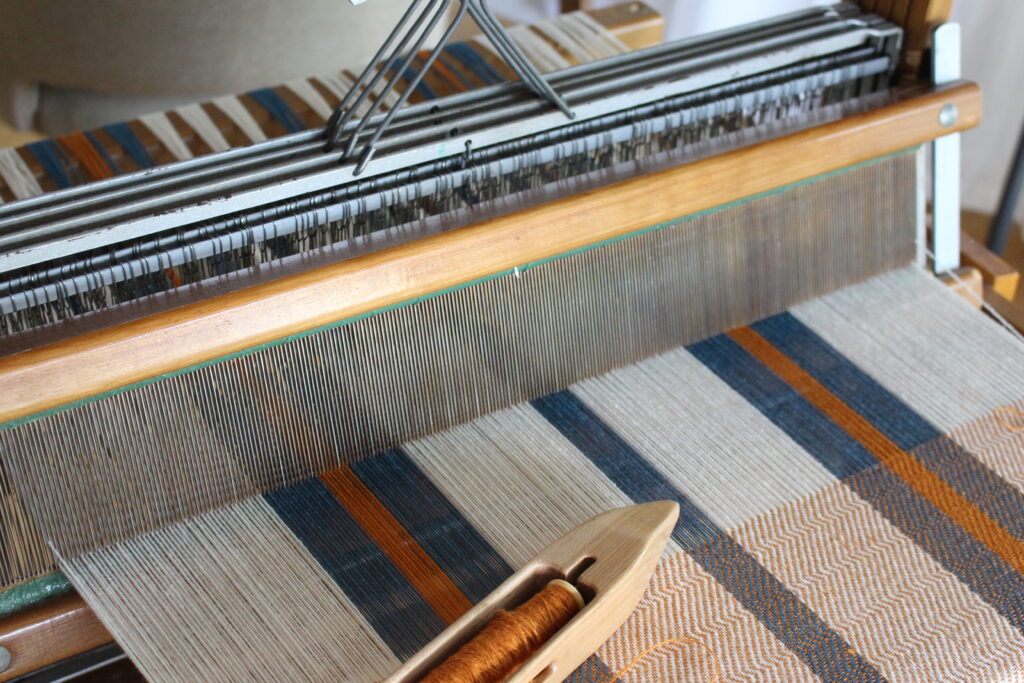
The project was 53cm (21”) wide on the loom. My warp measured close to 8.7m which was enough to weave 8 towels that all measured on average 90cm (36”).
This project has an EPI of 24. In total, there are 506 ends which includes 2 threads for floating selvedges.
I designed the warp pattern and it’s really simple. In the middle, there is a stripe of 2.5cm (1”) of blue. Then, there are two identical color blocks made of blue and orange. Those color blocks measure close to 8cm (3”) each. Separating all those blocks, I have solid blocks of natural.
100 %Cotton
This towel is my control group in this experiment. Cotton is the go-to yarn for weaving dishtowels and I understand why: it’s absorbent, easy to weave and it comes in so many colors. But will it be the most absorbent yarn of them all? For this towel, I repeated the same pattern found in the warp into the weft. But I only reproduced the blue and orange colors blocks. I did not weave a blue stripe to match the stripe found in the middle of the warp.
Here’s what I did in the warp:
-10cm (4”) of naturel
-2.5cm (1”) of blue
-8 picks of orange
-2.5cm (1”) of blue

I repeated this sequence until the end of the towel. I wove a simple 2/2 twill which can be found on page 32 of the book.
Cotton Slub
I find that cotton slub yarns are really interesting because of their irregular twist. This gives the towel a lot of texture. I had this yarn in only two colors: “natural” and “vieux blue” (old blue). I wove the first pattern on the top of page 34 of The Handweaver’s Pattern Directory by Anne Dixon.
In terms of color, I wove 3 repeats of the pattern in blue, and then 2 repeats of the pattern in naturel. I did this sequence for the whole towel.
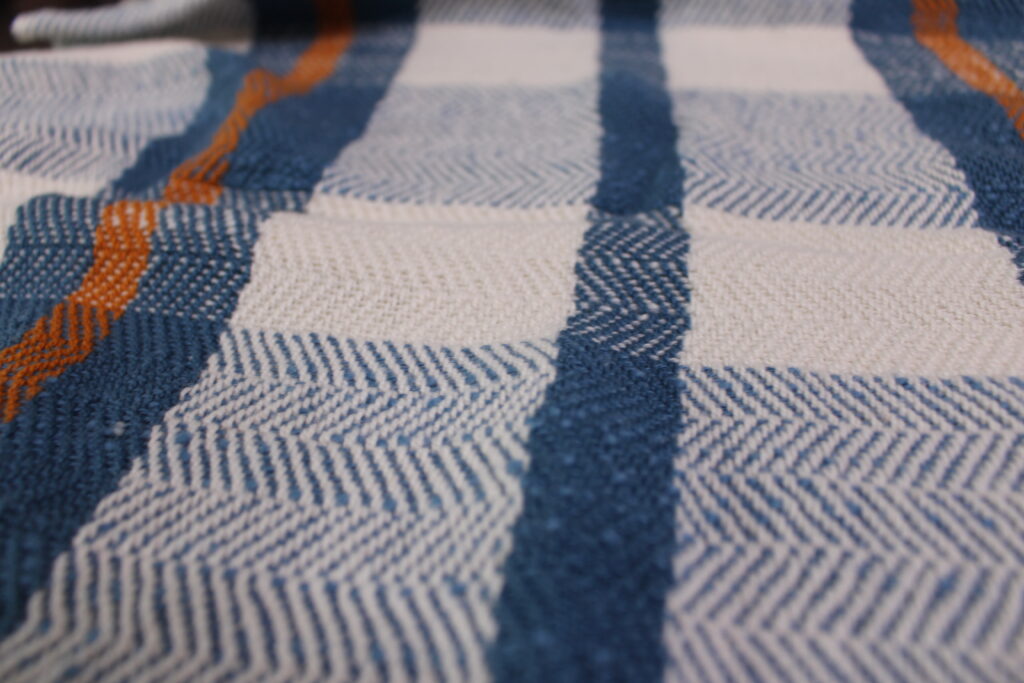
For my US friends, this Yarn is available at the Woolery here: https://woolery.com/cotton-slub-yarn.html?nosto=searchpage-nosto-1&aff=214
Hemp
I would lie if I said that the Hemp yarn isn’t already one of my favorite yarn. I find it really intriguing and I am pleased with how easy it was to weave with. I can’t wait to see how it will perform in my experiment.
The yarn used it 8/2 hemp from Maurice Brassard. For the pattern, I reproduced the one found in the middle of page 32 of the book.
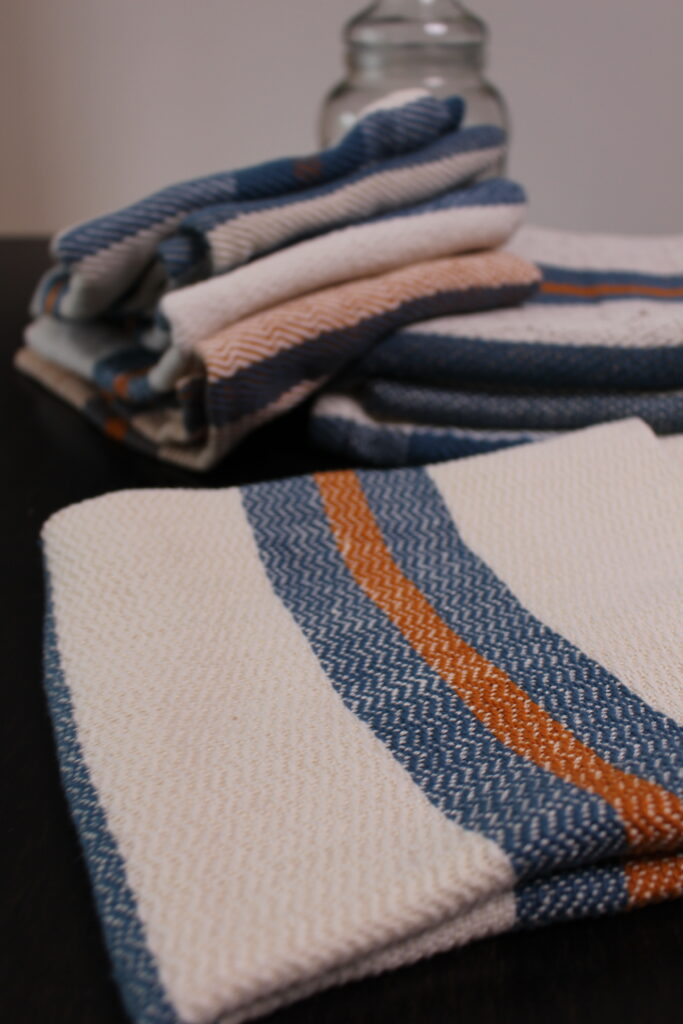
Cotton Bouclé
Cotton bouclé is really fun to weave with! It’s made with some little loops and somehow it reminds me of my curly hair. The only color I had was “stone” (8115) and it might have been a bit too dark for the warp colors of the towel. Still, I wove a 1/3 twill inspired by the first pattern on top of the page 36 in the book. This allowed for a towel that is different on both sides. On the first side, we can mainly see the warp and on the other, we can appreciate the weft and all its texture.
Check out the Woolery’s selection of color for Cotton boucle in the US:https://woolery.com/maurice-brassard-boucle-cotton-yarn.html?aff=214

Cotton Chenille
For this towel, I decided to use cotton chenille: my yarn discovery of this year! Still, I had in mind more a hand towel than a dish towel for this one. The yarn itself is really thick compared to the other yarns that I used so far in this fiber experiment. The final towel is thus also quite thick. I also wove a 1/3 twill for this towel to allow for a two-sided fabric. I used cotton chenille in the color white.
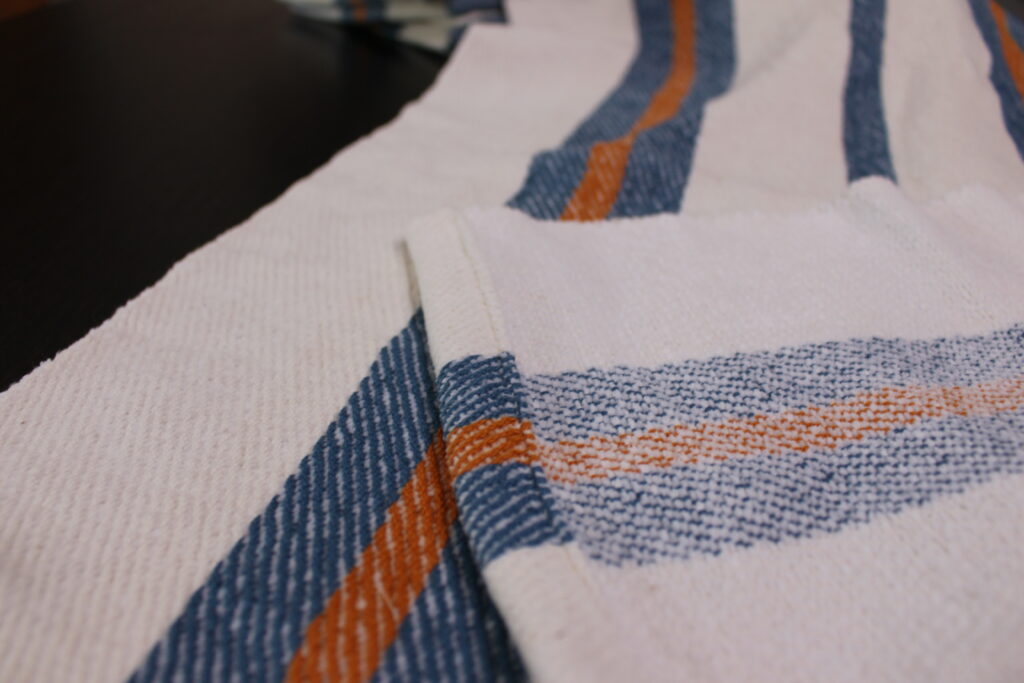
Cottonlin
This is one towel that I am really excited to see the results! I used cottonlin from Maurice Brassard in Orange Brulé, which is the same color found in the warp. I wove the draft found on the bottom of page 32 in the book. It’s such an intricate pattern and it really was easy to weave.
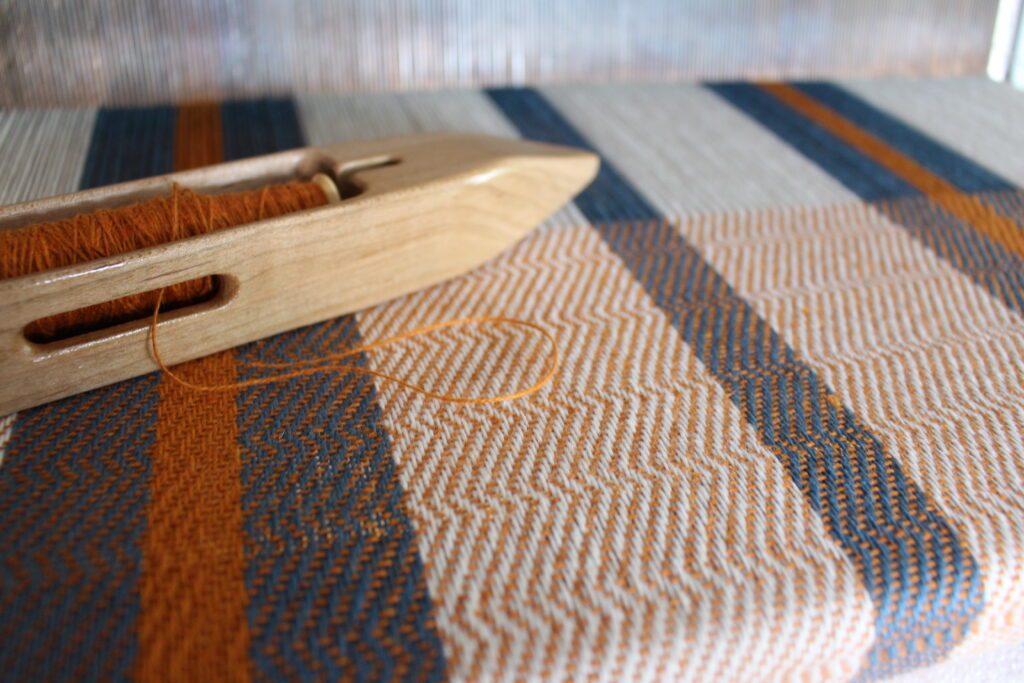
Bamboo
I used some 8/2 100% Bamboo from Maurice Brassard for this towel. The color is “coquille-(BB8027)” It’s shiny and soft and I really don’t know what to think of it! Right off the bat, I noticed that this yarn shrank the most out of all the other yarns. I did the draft in the middle of page 34 in the book.
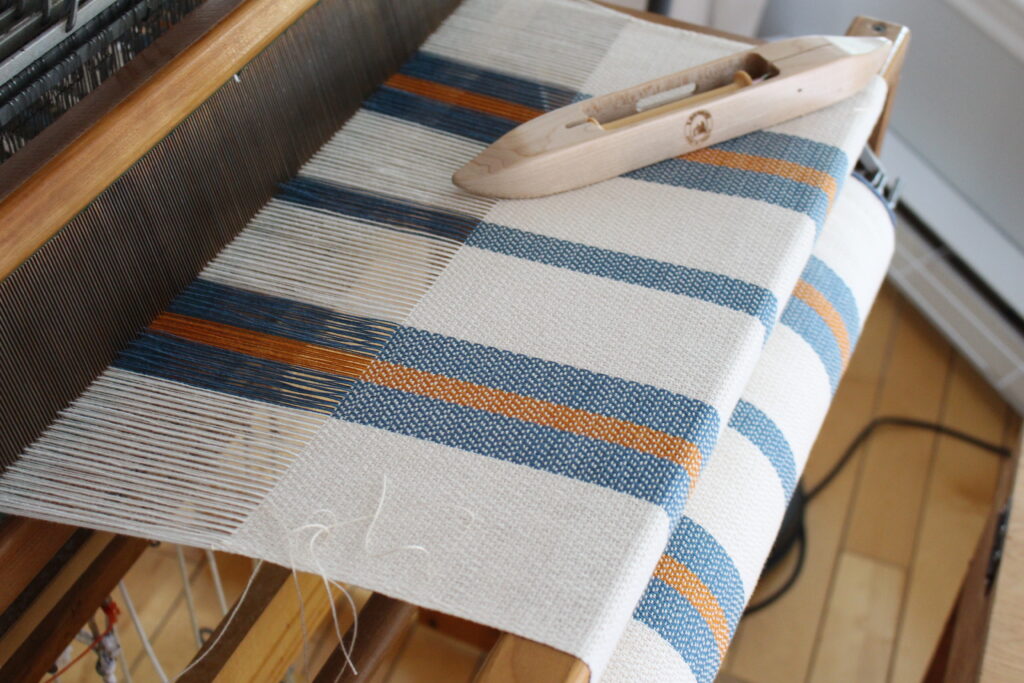
Linen
This is the surprise towel! Originally, I thought I would only have enough warp to weave for seven towels. But to my biggest joy, I had enough to weave one last one. I decided to use linen for this surprise towel, in the hope to make peace with this yarn. In a past sample, I had declared that linen is not my friend and I wish to give it a second chance. I did a simple 2/2 twill based on page 32 of Anne Dixon’s book.
I was so excited to read this.I am a new weaver,very new. I wanted to do something like this just to see what yarns I would like. But I couldn’t figure out the steps. How many inches did you leave between the towels? Did you machine hem them? Thank you for your help. I love your curly hair!
First of all, I wish to give you a warm welcome to the weaving world 🙂 To answer you, I left about half an inch in between my towels. I normally weave a few picks of scrap yarn to separate them. Also, I did machine hem them. I like to hem them after they have been washed once.
Bonjour ,
Félicitations pour vos vidéos.
Je viens de lire que vous avez tissé avec la fibre de Chenille de Coton acheté possible ment chez Maurice Brassard (que je connais, j’y achète aussi des fibres.)
J’aimerais en savoir plus sur votre expérience de tissage avec cette fibre.
1) la marchure à devoir utiliser car on me dit que l’on ne peut pas tisser comme avec le coton régulier 2/8
2)J’aimerais savoir votre résultat avec lavage machine laver et sécheuse SVP car on m’a dit que les fils ressortent et que la pièce est fichue
3)Je voudrais tisser des serviettes de bain sur mon métier à tisser ici à la maison.
4) merci de m’aider.. SVP plus facile en français pour moi..
Merciiiiiii à l’avance !
Bonne journée !